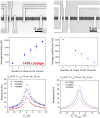Unveiling the carrier transport mechanism in epitaxial graphene for forming wafer-scale, single-domain graphene
- PMID: 28373575
- PMCID: PMC5402461
- DOI: 10.1073/pnas.1620176114
Unveiling the carrier transport mechanism in epitaxial graphene for forming wafer-scale, single-domain graphene
Abstract
Graphene epitaxy on the Si face of a SiC wafer offers monolayer graphene with unique crystal orientation at the wafer-scale. However, due to carrier scattering near vicinal steps and excess bilayer stripes, the size of electrically uniform domains is limited to the width of the terraces extending up to a few microns. Nevertheless, the origin of carrier scattering at the SiC vicinal steps has not been clarified so far. A layer-resolved graphene transfer (LRGT) technique enables exfoliation of the epitaxial graphene formed on SiC wafers and transfer to flat Si wafers, which prepares crystallographically single-crystalline monolayer graphene. Because the LRGT flattens the deformed graphene at the terrace edges and permits an access to the graphene formed at the side wall of vicinal steps, components that affect the mobility of graphene formed near the vicinal steps of SiC could be individually investigated. Here, we reveal that the graphene formed at the side walls of step edges is pristine, and scattering near the steps is mainly attributed by the deformation of graphene at step edges of vicinalized SiC while partially from stripes of bilayer graphene. This study suggests that the two-step LRGT can prepare electrically single-domain graphene at the wafer-scale by removing the major possible sources of electrical degradation.
Keywords: carrier transport; epitaxial graphene; single crystal; single domain.
Conflict of interest statement
The authors declare no conflict of interest.
Figures












References
-
- Novoselov KS, et al. Electric field effect in atomically thin carbon films. Science. 2004;306:666–669. - PubMed
-
- Lee C, Wei X, Kysar JW, Hone J. Measurement of the elastic properties and intrinsic strength of monolayer graphene. Science. 2008;321:385–388. - PubMed
-
- Seol JH, et al. Two-dimensional phonon transport in supported graphene. Science. 2010;328(5975):213–216. - PubMed
-
- Zhang Y, Tan Y-W, Stormer HL, Kim P. Experimental observation of the quantum Hall effect and Berry’s phase in graphene. Nature. 2005;438:201–204. - PubMed
-
- Novoselov KS, et al. Two-dimensional gas of massless Dirac fermions in graphene. Nature. 2005;438:197–200. - PubMed
LinkOut - more resources
Full Text Sources
Other Literature Sources

